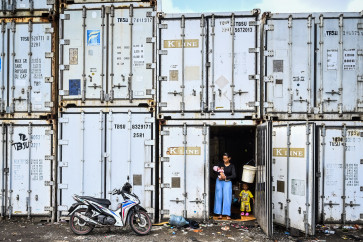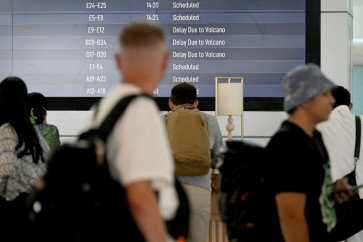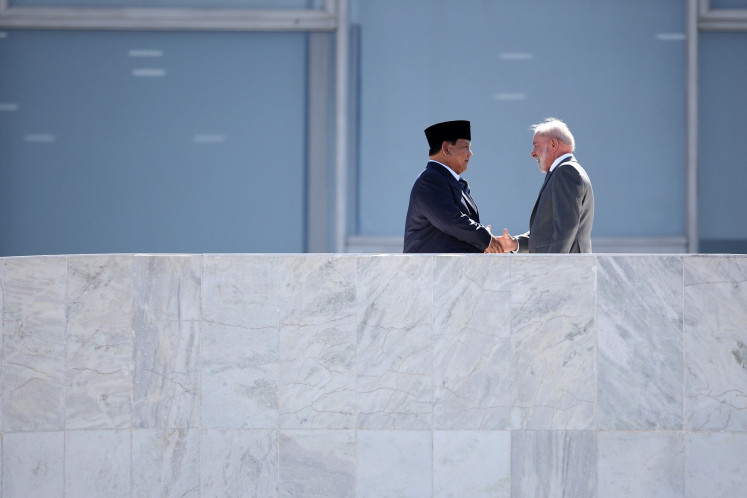Popular Reads
Top Results
Can't find what you're looking for?
View all search resultsPopular Reads
Top Results
Can't find what you're looking for?
View all search resultsWidodo: Color me softly
JP/Simon Sudarman By using natural dyes, batik maker Widodo is creating batik that is doubly attractive overseas for being both environmentally friendly and having a matte finish
Change text size
Gift Premium Articles
to Anyone
JP/Simon Sudarman
By using natural dyes, batik maker Widodo is creating batik that is doubly attractive overseas for being both environmentally friendly and having a matte finish.
Widodo was just a high school student when, in 1990, he first learned of the river pollution caused by the process of dyeing batik in centers such as Solo and Pekalongan in West Java.
“At that time I wondered how I could make a dye that didn’t pollute the environment,” says the Yogyakarta-based artisan, now a 35-year-old father of one.
He made it his mission to find natural materials to color batik, starting by asking older people and reading books.
His quest was spurred on when, in 1996, Holland rejected Indonesian batik because of its perceived danger to the environment, batik makers and batik users.
His quest was focused on producing the three special colors used for batik from the Yogyakarta palace: blue, brown and black.
“In looking for the colors to produce natural dyes I tried using all sorts of leaves, stems, roots, peels and tree branches, mainly by boiling,” he says, explaining that he experimented with ideas for materials he found in books.
Finally, he succeeded: Boiling bark from mahogany trees gave him brown, soaking a mixture of indigo stems and leaves in dissolved limestone gave him blue. Black he made by blending the other two colors.
“The process is quite difficult, especially making the blue from indigo. The fact is, I have to keep doing the processing so I can find suitable materials … that give high-quality natural colors.”
The unusual and lengthy process begins even at the collection of materials – indigo cuttings cannot be taken in the afternoon because that is when photosynthesis increases, resulting in a lower color intensity.
The indigo cuttings are soaked in water for 24 to 35 hours. After six hours, the blue emerges and the water turns green. After mixing with limestone, a blue foam appears, which gradually becomes blue-black.
“This signifies the end of the process and the mixture is allowed to precipitate overnight. The next day it can be used to dye batik,” Widodo explains.
After a lengthy process of trial and error, Widodo believed he had finally found the right natural dyes, and in 2000 set out to sell his products, finding customers among designers and batik makers from regions in Java such as Pekalongan, Solo, Semarang, Bandung and Jakarta.
He continued to seek other colors, ultimately coming up with a range of plants from which he could create a palette of quality natural batik colors.
Mango leaves gave him a light green, as does Mimosa pudica (Putri Malu, or Shy Princess), and betel nuts produce red. Even dung from cattle fed dried rice stalks can create a golden yellow dye, while dung from cows fed grass gives dark brown.
“To create these colors I keep three cows,” Widodo says with a laugh.
In their final form, the natural colors are paste, which he sells at Rp 40,000 to Rp 50,000 a kilogram.
Once he had the dyes in place, Widodo pursued the other part of his dream – making batik.
The process required using natural dyes was different from that for synthetic dyes, into which fabric needs to be dipped only once and is ready in one day. With natural dyes “the dipping process must be carried out many times, at least seven and up to 20 times, over seven days”, he explains.
He also found that, using his natural dyes, the result was not glossy, as from synthetic dyes, but matte.
Locally, this caused problems as “many people hesitate to make it because they’re afraid it will not sell”. On the upside, he says, “This lack of glossiness is preferred by foreign tourists because it creates a feeling of nostalgia.”
There was no question, then, where to market his products. The tricky and time-consuming process that makes his cloth too expensive for the local market is part of the attraction for the international market.
“Because the manufacturing process takes a long time, is unique and difficult, it impresses foreign tourists,” explains Widodo, who has been an active member of Sekar Jagad, an organization of batik lovers, since 2000. “The process and the uniqueness of natural batik means that they appreciate why it is expensive, and it sells out.”
He also guarantees to his customers that the colors will not fade in a year if the batik is kept dry and aired.
The kinds of prices his products fetch – for example, Rp 100,000 (US$10) for a natural silk batik shawl – are higher than those for synthetic batik, because of the process.
Widodo’s company, Tom Batik, which has 17 employees, is the only natural batik business in Kulonprogo in Yogyakarta. Its products are finding popularity among tourists from Europe, Japan and the United States.
“Once in 2006 I had 65 customers from Japan,” he says. “They came here especially to see the natural batik-making process and after they were satisfied and sure of it, they ordered so much cloth for kimonos using natural batik that we were kept busy for a long time.”










